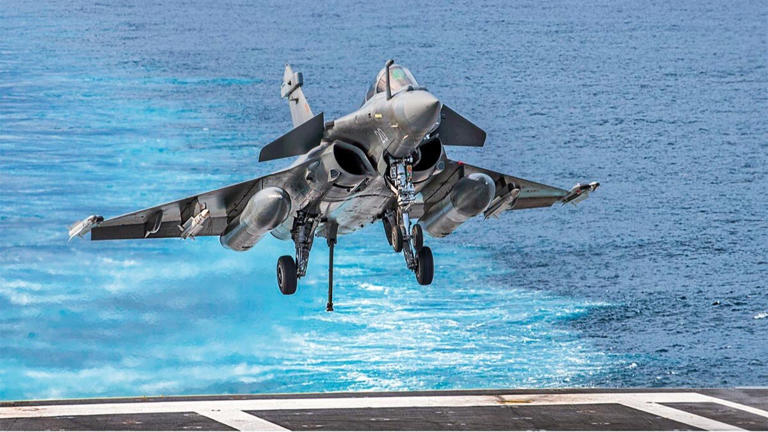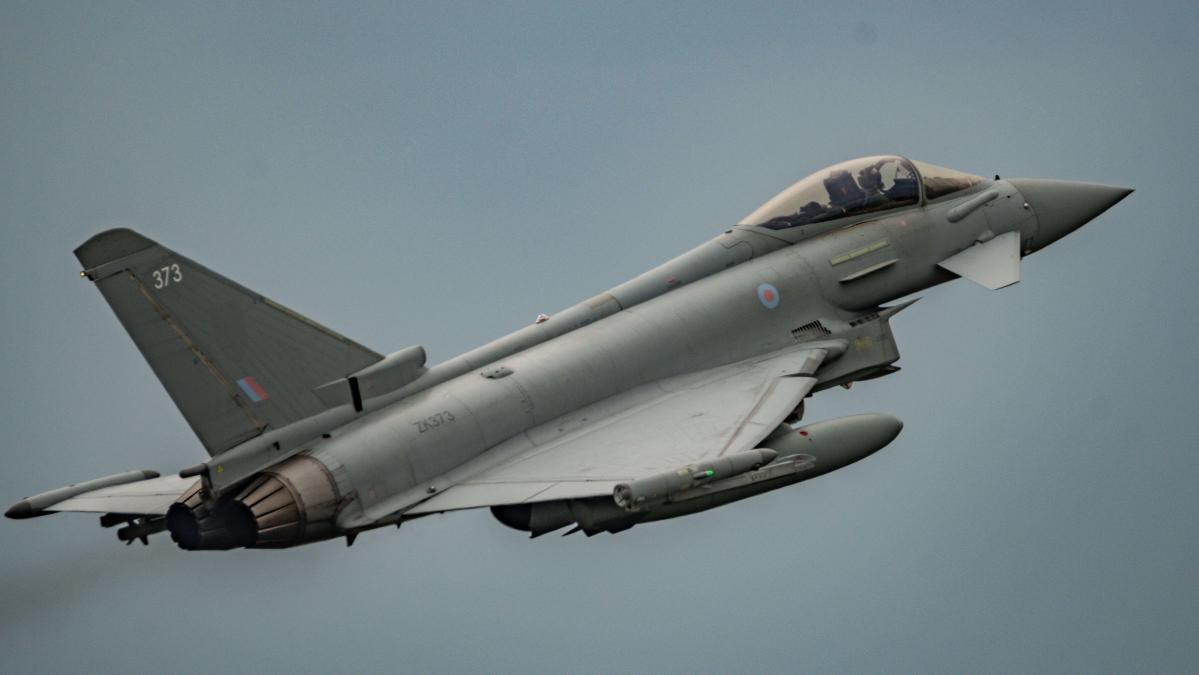Deal to buy 26 Rafale M | The Navy gets new wings
Story by Pradip R. Sagar •1w

Deal to buy 26 Rafale M | The Navy gets new wings© Provided by India Today
At last, after nearly a year of deliberations, the matter of selecting fighter aircraft for India's newly inducted indigenous aircraft carrier, INS Vikrant, has been settled. On July 13, when Prime Minister Narendra Modi was on his way to Paris for a two-day visit, a meeting of the Defence Acquisition Council (DAC) convened by defence minister Rajnath Singh granted the Acceptance of Necessity (AoN) to the Indian Navy to acquire 26 Rafale Marine (Rafale-M) fighter jets from France. The deal to procure the Rafale-Ms will cost India at least $8 billion (Rs 65,920 crore) and will be executed through an inter-governmental agreement between India and France. India will acquire 22 single-seater Rafale-Ms and four of its twin-seater trainer versions. They are expected to be based at Visakhapatnam, the home base of INS Vikrant. According to military aviators, the Rafale-M is considered among the world's most advanced carrier-borne fighter jets, and its induction in the Indian Navy will add immense capability in terms of its strike, air defence and reconnaissance missions.
The AoN being the first stage of a long-drawn process of defence procurement, officials involved in negotiations claim that it will take months, or even a year, to finalise the Rafale-M deal. Once the negotiations on cost and techno-commercial details are concluded, the deal will require final clearance from the Cabinet Committee on Security chaired by PM Modi before being finally inked. The first Rafale-M is expected to arrive in India at least two-three years after the contract is signed. However, some MoD officials say that given the urgency of the matter, the Indian Navy might ask Rafale manufacturer Dassault Aviation to spare at least four or five Rafale-Ms from its ongoing orders for the French navy.
Though expectations were high that Modi may announce the deal after bilateral discussions with French president Emanuel Macron in Paris, the Rafale-M did not figure in the joint statement by the leaders. Some in the Indian government believe that given the controversy and Opposition criticism following Modi's announcement in 2015 about the acquisition of 36 Rafales for the Indian Air Force, the PM has taken a cautious approach this time, especially considering the fast approaching Lok Sabha election in 2024. However, Dassault Aviation in a press release on July 14 announced that the India had selected the naval variant of Rafale fighter jets for its navy.
The Rafale-M was in contention along with the US's Boeing F/A-18 Super Hornet for the flight deck of INS Vikrant. Last year, both fighters displayed their capabilities during trials at the shore-based INS Hansa test facility in Goa, which simulated the deck of INS Vikramaditya, the navy's other aircraft carrier. The two fighters went through extensive capability trials, including take-off on a ski-jump ramp. This technique, called short take-off but arrested recovery or STOBAR, is used on INS Vikramaditya and INS Vikrant. In the end, the Rafale-M was deemed more suitable by the navy.
Road to Rafale
The Indian Navy has been operating the Russian-made Mikoyan-Gurevich MiG-29K fighters from its aircraft carriers ever since the British-made Sea Harriers were phased out after serving for almost three decades. In 2004 and in 2010, 45 MiG-29Ks and associated equipment were ordered at a cost of $2.2 billion (nearly Rs 14,000 crore) in two tranches from Russia. But the MiG-29Ks that operate from INS Vikramaditya had a terrible record of accidents, with five aircraft crashing in the past four years, most recently in October 2022. In addition, a 2016 report by the Comptroller and Auditor General (CAG) flagged the occurrence of mid-air engine failures and defects in the airframe of the MiG-29K. "The MiG-29K, which is a carrier-borne multi-role aircraft…is riddled with problems relating to the airframe, RD MK-33 engine and fly-by-wire system," the report had said. This ruled out the MiG-29k for service in the navy's second, newest aircraft carrier, the INS Vikrant.
In 2019, the Indian Navy initiated the process to acquire 57 multi-role combat aircraft for its carriers. Simultaneously, India's indigenous Twin Engine Deck Based Fighter (TEDBF) is being developed by the Aeronautical Development Agency (ADA), a department of the Defence Research and Development Organisation (DRDO). But it is still in the research and development stage, with the first test flight expected by 2026 and induction by 2031. Till that time, the navy decided to get 26 fighter aircraft for INS Vikrant as a 'stopgap arrangement'. Twelve Russian-origin MiG-29Ks are likely to be deployed on INS Vikrant till the Rafale-Ms join the naval fleet.
After sustained trials of the Rafale-M and the bigger Boeing F/A-18 Super Hornet, the navy in its report to the MoD in December 2022 stated that the French fighter jet was found to be "more suitable in meeting the operational requirements and criteria". Naval sources claim that the F-18 had difficulty fitting into the INS Vikrant's elevator even with its foldable wings. This was a big operational handicap. Though the Rafale-M does not have foldable wings, Dassault has agreed to make design changes—like tweaking the pylon structure of the aircraft—to make it suitable for the Vikrant. This enabled it to clear the Navy's technical parameters.
https://www.msn.com/en-in/video/new...-weapons-into-rafale-fighter-jets/vi-AA1efS0g
An all-round machine
Rafale-M is a twin-engine, single-seat aircraft capable of undertaking 'quick reaction alert', air defence and air policing missions, air support for ground forces and reconnaissance missions. It can also be used for deep strikes in enemy territory, for projecting power and for nuclear deterrence. The Rafale-M can carry out air-to-ground as well as air-to-air strikes during the same sortie. Its "service ceiling"—the altitude at which an aircraft can no longer rise faster than 100 feet per minute under standard air conditions—stands at 50,000 feet.
Experts say that naval jets possess specialised avionics, sensors, and communication equipment for maritime/ carrier operations. According to Dassault, Rafale-M has specific capabilities like the RBE2 electronic scanning radar, Front Sector Optronics (FSO) that allows targets to be detected and tracked and SPECTRA internal 'electronic warfare' (EW) systems for long-range detection and identification of hostile radars, missiles and lasers. In addition, Rafale's unique data fusion capability yields a simplified and consolidated picture to the pilot. The Rafale-M is equipped with the Safran Group's reinforced landing gear as well as tailhooks that attach themselves to cables strung across the carrier deck, enabling the aircraft to be brought to a stop.
Former navy chief Admiral Arun Prakash, a naval pilot himself, endorses the navy's choice, adding that Rafale-M is currently the most advanced carrier-borne jet in its class. "It has got good sensors, can carry a variety of weapons and has good endurance, which brings tremendous enhancement of capability. Carrier-based fighters can go 300-400 miles to strike enemy territory or targets, affording an enhanced strike range. It provides air defence against enemy attacks and can be the navy's eyes and ears in the sky over the sea," Adml Prakash adds.
Defence officials say that since the IAF is flying 36 Rafale jets, which shares over 80 per cent of its components with the Rafale-M, the navy's deal will bring commonality as well as savings on training and maintenance. According to Dassault, after the Navy gets its Rafale-Ms, it would make India the first country after France to operate both versions of the aircraft.
The Rafale-M can carry up to 9.5 tonnes of weapons, fuel tanks and pods on 13 external hardpoints, and is capable of low-level, high-speed penetrations to evade enemy radar. It can be equipped with weapons like the METEOR very long-range air-to-air missile, MICA air-to-air "Beyond Visual Range" (BVR) interception, combat and self-defence missiles, in their IR (infrared) heat-seeking (detecting hot engine plumes of targets) and active radar homing (using inbuilt radars to detect targets) versions. It can also use the HAMMER (Highly Agile and Manoeuvrable Munition Extended Range) modular, rocket-boosted air-to-ground precision-guided weapon series, SCALP long-range stand-off missile, AM39 EXOCET anti-ship missile, laser-guided bombs with different warheads and seekers, and the 2,500 rounds/minute NEXTER 30M791 30 mm internal cannon. The website of Dassault Aviation says the Rafale-M is capable of several complex actions during the same sortie—termed 'omnirole' capability—like firing air-to-air missiles during a low-altitude penetration phase.
Built to withstand the challenges of saltwater environments, naval jets incorporate corrosion-resistant materials and coatings. Accordingly, Rafale-M has a robust airframe and undercarriage made of advanced composite materials and corrosion-resistant alloys to provide protection against rust, and to ensure perfect aircraft performance even in severe environments. While naval fighter jets generally have shorter ranges, they boast in-flight refuelling capabilities, ensuring extended operational endurance during critical missions. Rafale-M is no exception.
According to Dassault, the French Navy Rafale-Ms operating from the aircraft carrier Charles De Gaulle served with efficiency in Syria in 2015. In 2011, Rafales and Rafale-Ms also took part in operations over Libya.
The effective use of these latest jets from the deck of India's new, indigenous aircraft carrier can yield significant results. Carriers are ideal for sea control and power projection. In military parlance, sea control is exercised using a combination of warships, fixed-wing aircraft, helicopters and amphibious platforms. INS Vikrant and INS Vikramaditya are crucial for operations in the Indian Ocean Region, where, too, India faces the spreading tentacles of an aggressive China.
"Fighter jets for an aircraft carrier are like the eyes, ears and soul of the fleet. Without fighter jets, the aircraft carrier fleet is helpless," says Adml Prakash. The 26 Rafale-Ms are expected to play that role to perfection and help further India's maritime objectives.







